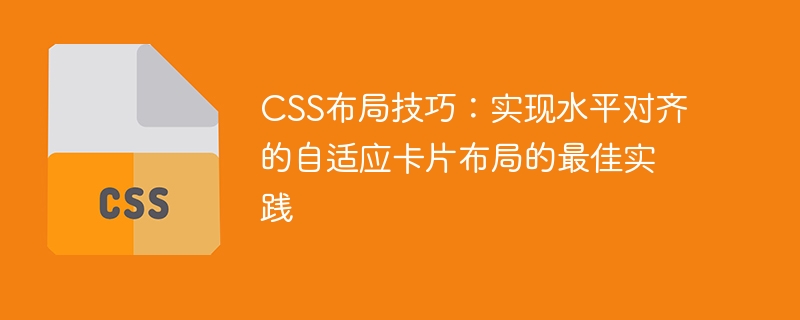

CSS Layout Tips: Best Practices for Implementing Horizontally Aligned Adaptive Card Layout
In web design, we often encounter card layouts that require horizontal alignment. Such as photo wall, product display, etc. How to implement a beautiful and adaptive horizontally aligned card layout is the focus of every front-end developer. This article will introduce some CSS layout techniques to help you implement horizontally aligned adaptive card layout, and come with specific code examples.
HTML:
<div class="card-container"> <div class="card">Card 1</div> <div class="card">Card 2</div> <div class="card">Card 3</div> <div class="card">Card 4</div> </div>
CSS:
.card-container {
display: flex;
justify-content: center;
align-items: center;
}
.card {
width: 200px;
height: 200px;
background-color: #ccc;
margin: 10px;
}In the above code, we set the card container to flex layout, Horizontal center alignment can be achieved through justify-content: center, and vertical center alignment can be achieved through align-items: center. By adjusting the width and height of .card, you can control the size of the card.
HTML:
<div class="card-container"> <div class="card">Card 1</div> <div class="card">Card 2</div> <div class="card">Card 3</div> <div class="card">Card 4</div> </div>
CSS:
.card-container {
display: grid;
grid-template-columns: repeat(auto-fit, minmax(200px, 1fr));
justify-items: center;
align-items: center;
grid-gap: 10px;
}
.card {
width: 100%;
height: 200px;
background-color: #ccc;
}In the above code, we set the card container to a grid layout. grid-template-columnsAttributes can set the number and width of columns. Through repeat(auto-fit, minmax(200px, 1fr)), adaptive column width can be achieved. Each row will Try to accommodate as many cards as possible, and the minimum width is 200px. The center alignment of the card can be achieved through justify-items: center and align-items: center. By adjusting the height of .card, you can control the height of the card.
HTML:
<div class="card-container"> <div class="card">Card 1</div> <div class="card">Card 2</div> <div class="card">Card 3</div> <div class="card">Card 4</div> </div>
CSS:
.card-container {
position: relative;
}
.card {
position: absolute;
width: 200px;
height: 200px;
background-color: #ccc;
margin: 10px;
left: 50%;
transform: translateX(-50%);
}In the above code, we set the card container to be relatively positioned ( position: relative), then set the card to absolute positioning (position: absolute). By setting left: 50%, center-align the left edge of the card, and by transform: translateX(-50%), move the card to the left by half its width to achieve horizontal center alignment. .
The above are three CSS layout techniques to achieve horizontally aligned adaptive card layout. You can choose one of the methods that suits you according to your specific needs. Hopefully these code examples will help you improve your web design and achieve better horizontally aligned card layouts.
The above is the detailed content of CSS Layout Tips: Best Practices for Implementing Horizontally Aligned Adaptive Card Layout. For more information, please follow other related articles on the PHP Chinese website!




